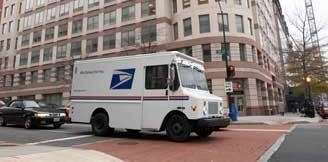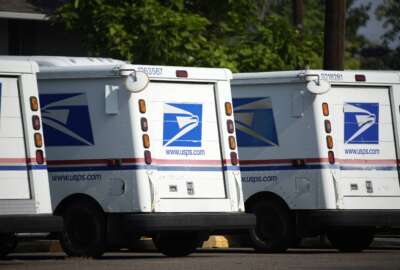USPS doubles initial order for electric vehicles under next-generation fleet contract
The Postal Service, under intense pressure from Congress and the Biden administration, has doubled its initial order for electric vehicles as part of its...
The Postal Service, facing intense pressure from Congress and the Biden administration, has doubled its initial order for electric vehicles as part of its next-generation delivery vehicle (NGDV) fleet.
USPS announced Thursday it spent nearly $3 billion on 50,000 next-generation vehicles as part of its initial order to the vendor Oshkosh Defense. More than 10,000 vehicles as part of that initial order are electric vehicles.
USPS said in a statement last month it planned to buy 5,000 electric vehicles as part of its initial order. The agency said it has the flexibility to increase the total number of electric vehicles, “should additional funding become available.”
Postmaster General Louis DeJoy said in a statement Thursday that USPS is “fully committed to the inclusion of electric vehicles as a significant part of our delivery fleet,” even though electric vehicles will cost the agency more up front than gas-powered vehicles.
“We will continue to look for opportunities to increase the electrification of our delivery fleet in a responsible manner, consistent with our operating strategy, the deployment of appropriate infrastructure, and our financial condition, which we expect to continue to improve as we pursue our plan,” DeJoy said.
USPS, over the Biden administration’s objections, finalized plans last month to purchase up 148,500 new internal-combustion vehicles over the next decade, and committed to making electric vehicles at least 10% of its next-generation fleet.
Those plans, however, fell short of the administration’s expectations.
Brenda Mallory, the Chairwoman of the White House’s Council on Environmental Quality, said last month that the agency’s plans to buy a mostly gas-powered fleet were “out of touch with technology and puts the agency at a major disadvantage to its competitors, who are all going electric.”
Vicki Arroyo, EPA’s associate administrator for policy, said USPS’s plans to purchase tens of thousands of gasoline-powered delivery trucks over the next decade “locks USPS into further oil dependence, air pollution and climate impacts for decades to come, and harms the long-term prospects of our nation’s vital mail provider.”
USPS owns about a third of all federal vehicles, and ranks second only to the Defense Department in terms of agencies with the largest vehicle inventory. The agency’s plans to purchase mostly gas-powered delivery vehicles for the next decade runs counter to the Biden administration’s vision for net-zero emissions from the federal government.
DeJoy said USPS has continuously evaluated its vehicle purchase strategy based on its future network initiatives, an ongoing review of how electric vehicles fit into its operational strategy and implementation of its 10-year reform plan.
“Based upon this work and our improving outlook, we have determined that increasing our initial electric vehicle purchase from 5,000 to 10,019 makes good sense from an operational and financial perspective,” DeJoy said.
House Democrats recently sought to block the Postal Service from buying mostly gas-powered vehicles as part of its next-generation fleet.
House Oversight and Reform Subcommittee on Government Operations Chairman Gerry Connolly (D-Va.) recently led 68 other representatives in introducing the Green Postal Service Fleet Act.
The bill would prohibit USPS from carrying out any new purchase of a new fleet of delivery vehicles unless 75% of the new vehicles are electric or zero-emission.
Connolly, however, said in a statement Thursday that USPS still isn’t doing enough to make electric vehicles a major part of its next-generation fleet, and urged Congress must pass the Green Postal Service Fleet Act.
“This is still woefully short of what the USPS should do in transitioning to the clean EV vehicle fleet of tomorrow. It’s time to be bold and visionary, not settle for a Band-Aid on this problem,” Connolly said.
USPS has repeatedly offered to order more electric vehicles if Congress approves funding for the purchase.
USPS would have received $6 billion in the Build Back Better Act to invest in more electric vehicles and the necessary infrastructure to charge them. The spending package, however, doesn’t have enough support in the Senate and is unlikely to pass in its current state.
Administration officials and lawmakers, however, say the agency has the ability to purchase more electric vehicles on its own. Congress recently passed the Postal Service Reform Act, which is expected to save the agency $107 billion.
The agency, meanwhile, has more than $24 billion cash on hand, according to recent data from the Treasury Department.
DeJoy, however, said USPS cannot wait any longer for new vehicles. Many of its 190,000 delivery vehicles on the road are more than 30 years old, and lack basic safety features that are standard in most vehicles today.
“The safety of the men and women of the Postal Service is our number one priority, and they have waited long enough for the NGDV,” DeJoy said.
The next-generation vehicles include 360-degree cameras, advanced braking and traction control, airbags and a front-and rear-collision avoidance system that includes visual, audio warning, and automatic braking.
Copyright © 2025 Federal News Network. All rights reserved. This website is not intended for users located within the European Economic Area.
Jory Heckman is a reporter at Federal News Network covering U.S. Postal Service, IRS, big data and technology issues.
Follow @jheckmanWFED






